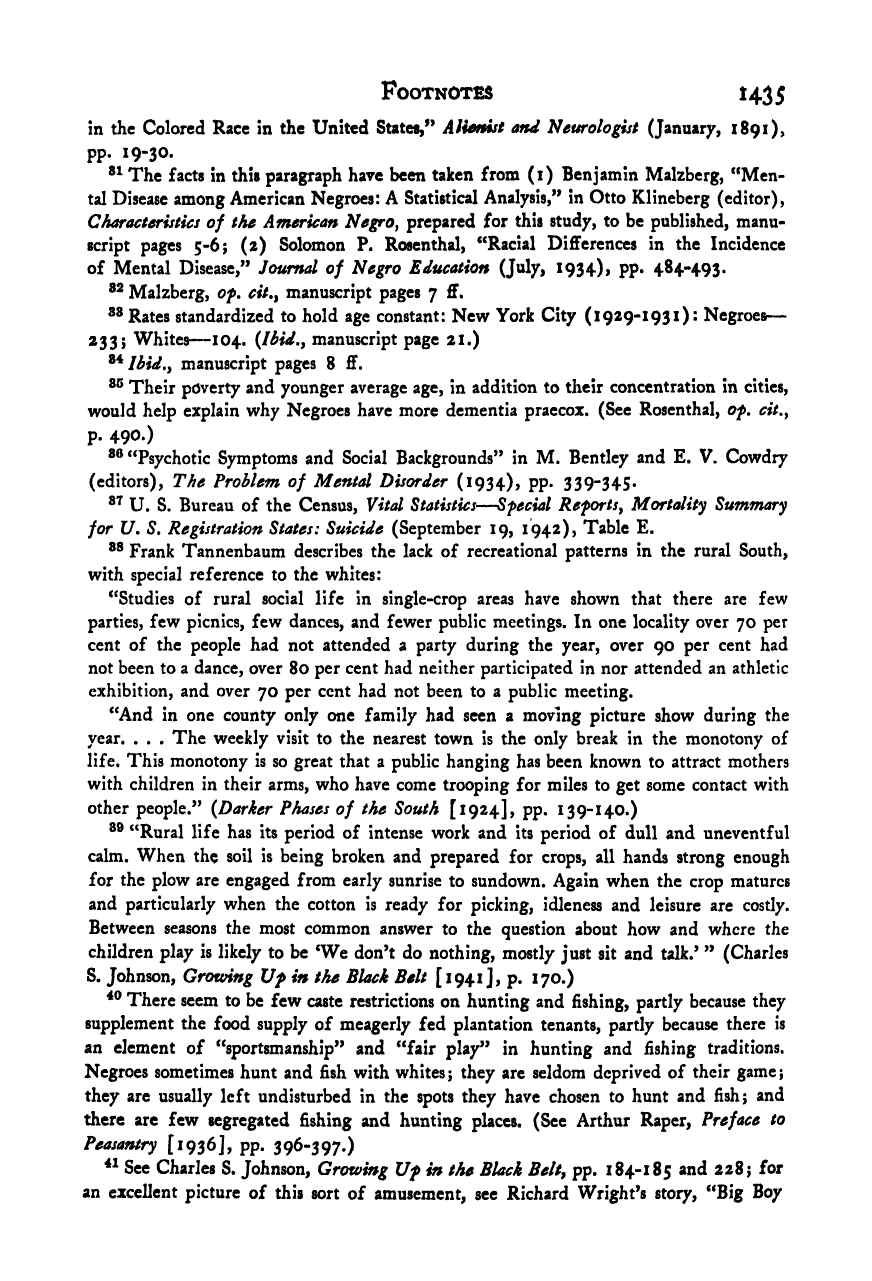Note: Gunnar Myrdal died in 1987, less than 70 years ago. Therefore, this work is protected by copyright, restricting your legal rights to reproduce it. However, you are welcome to view it on screen, as you do now. Read more about copyright.
Full resolution (TIFF) - On this page / på denna sida - Footnotes - Chapter 44

<< prev. page << föreg. sida << >> nästa sida >> next page >>
Below is the raw OCR text
from the above scanned image.
Do you see an error? Proofread the page now!
Här nedan syns maskintolkade texten från faksimilbilden ovan.
Ser du något fel? Korrekturläs sidan nu!
This page has never been proofread. / Denna sida har aldrig korrekturlästs.
Footnotes 1435
in the Colored Race in the United States,” Aliemst and Neurologist (January, 1891),
pp. 19-30.
The facts in this paragraph have been taken from (i) Benjamin Malzberg, “Men-
tal Disease among American Negroes: A Statistical Analysis,” in Otto Klineberg (editor),
Characteristics of the American Negro^ prepared for this study, to be published, manu-
script pages 5-6; (2) Solomon P. Rosenthal, “Racial Differences in the Incidence
of Mental Disease,” Journal of Negro Education (July, 1934), pp. 484-493.
Malzberg, of. cit.^ manuscript pages 7 ff.
Rates standardized to hold age constant: New York City ( 19^9*^ 931 ) • Negroes
233; Whites—104. {Jbid.y manuscript page 21.)
Ibid.y manuscript pages 8 ff.
Their poverty and younger average age, in addition to their concentration in cities,
would help explain why Negroes have more dementia praecox. (See Rosenthal, of. cit.y
p. 490.)
“Psychotic Symptoms and Social Backgrounds” in M. Bentley and E. V. Cowdry
(editors). The Problem of Mental Disorder (1934), pp. 339“345.
U. S. Bureau of the Census, Vital Statistics—Sfecial RefortSy Mortality Summary
for U. S. Registration States: Suicide (September 19, 1942), Table E.
Frank Tannenbaum describes the lack of recreational patterns in the rural South,
with special reference to the whites:
“Studies of rural social life in single-crop areas have shown that there are few
parties, few picnics, few dances, and fewer public meetings. In one locality over 70 per
cent of the people had not attended a party during the year, over 90 per cent had
not been to a dance, over 80 per cent had neither participated in nor attended an athletic
exhibition, and over 70 per cent had not been to a public meeting.
“And in one county only one family had seen a moving picture show during the
year. . . . The weekly visit to the nearest town is the only break in the monotony of
life. This monotony is so great that a public hanging has been known to attract mothers
with children in their arms, who have come trooping for miles to get some contact with
other people.” {Darker Phases of the South [1924], pp. 1 39-140.)
30
“Rural life has its period of intense work and its period of dull and uneventful
calm. When the soil is being broken and prepared for crops, all hands strong enough
for the plow are engaged from early sunrise to sundown. Again when the crop matures
and particularly when the cotton is ready for picking, idleness and leisure are costly.
Between seasons the most common answer to the question about how and where the
children play is likely to be ‘We don’t do nothing, mostly just sit and talk.’ ” (Charles
S. Johnson, Growing Uf in the Black Belt [1941], p. 170.)
There seem to be few caste restrictions on hunting and fishing, partly because they
supplement the food supply of meagerly fed plantation tenants, partly because there is
an element of “sportsmanship” and “fair play” in hunting and fishing traditions.
Negroes sometimes hunt and fish with whites; they are seldom deprived of their game;
they are usually left undisturbed in the spots they have chosen to hunt and fish; and
there are few segregated fishing and hunting places. (See Arthur Raper, Preface to
Peasantry [1936], pp. 396-
397*)
See Charles S. Johnson, Growing Uf in the Black Belty pp. 184-185 and 228; for
an excellent picture of this sort of amusement, see Richard Wright’s story, “Big Boy
<< prev. page << föreg. sida << >> nästa sida >> next page >>